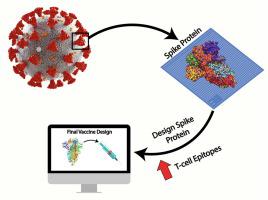Computational and Structural Biotechnology Journal ( IF 6 ) Pub Date : 2020-12-31 , DOI: 10.1016/j.csbj.2020.12.039 Edison Ong , Xiaoqiang Huang , Robin Pearce , Yang Zhang , Yongqun He

|
The development of effective and safe vaccines is the ultimate way to efficiently stop the ongoing COVID-19 pandemic, which is caused by severe acute respiratory syndrome coronavirus 2 (SARS-CoV-2). Built on the fact that SARS-CoV-2 utilizes the association of its Spike (S) protein with the human angiotensin-converting enzyme 2 (ACE2) receptor to invade host cells, we computationally redesigned the S protein sequence to improve its immunogenicity and antigenicity. Toward this purpose, we extended an evolutionary protein design algorithm, EvoDesign, to create thousands of stable S protein variants that perturb the core protein sequence but keep the surface conformation and B cell epitopes. The T cell epitope content and similarity scores of the perturbed sequences were calculated and evaluated. Out of 22,914 designs with favorable stability energy, 301 candidates contained at least two pre-existing immunity-related epitopes and had promising immunogenic potential. The benchmark tests showed that, although the epitope restraints were not included in the scoring function of EvoDesign, the top S protein design successfully recovered 31 out of the 32 major histocompatibility complex (MHC)-II T cell promiscuous epitopes in the native S protein, where two epitopes were present in all seven human coronaviruses. Moreover, the newly designed S protein introduced nine new MHC-II T cell promiscuous epitopes that do not exist in the wildtype SARS-CoV-2. These results demonstrated a new and effective avenue to enhance a target protein’s immunogenicity using rational protein design, which could be applied for new vaccine design against COVID-19 and other pathogens.
中文翻译:

通过T细胞表位工程设计SARS-CoV-2刺突糖蛋白以提高免疫原性的计算设计
开发有效和安全的疫苗是有效阻止持续的COVID-19大流行的最终方法,这种大流行是由严重的急性呼吸综合征冠状病毒2(SARS-CoV-2)引起的。基于SARS-CoV-2利用其Spike(S)蛋白与人类血管紧张素转化酶2(ACE2)受体的结合侵入宿主细胞这一事实,我们通过计算重新设计了S蛋白序列,以提高其免疫原性和抗原性。为此,我们扩展了进化蛋白设计算法EvoDesign,以创建数千种稳定的S蛋白变异体,这些变异扰动核心蛋白序列,但保留表面构象和B细胞表位。计算并评估了T细胞表位的含量和扰动序列的相似性得分。在22,914个具有良好稳定性能的设计中,301个候选物包含至少两个预先存在的与免疫相关的表位,并具有很有希望的免疫原性潜力。基准测试表明,尽管EvoDesign的评分功能未包含表位限制,但顶级S蛋白设计已成功地从天然S蛋白的32种主要组织相容性复合体(MHC)-II T细胞混杂表位中回收了31种,在所有七种人类冠状病毒中都存在两个表位。此外,新设计的S蛋白引入了九种新的MHC-II T细胞混杂表位,这些表位在野生型SARS-CoV-2中不存在。这些结果表明,使用合理的蛋白质设计可以提高靶蛋白的免疫原性,这是一种新的有效途径,可用于针对COVID-19和其他病原体的新疫苗设计。



























 京公网安备 11010802027423号
京公网安备 11010802027423号